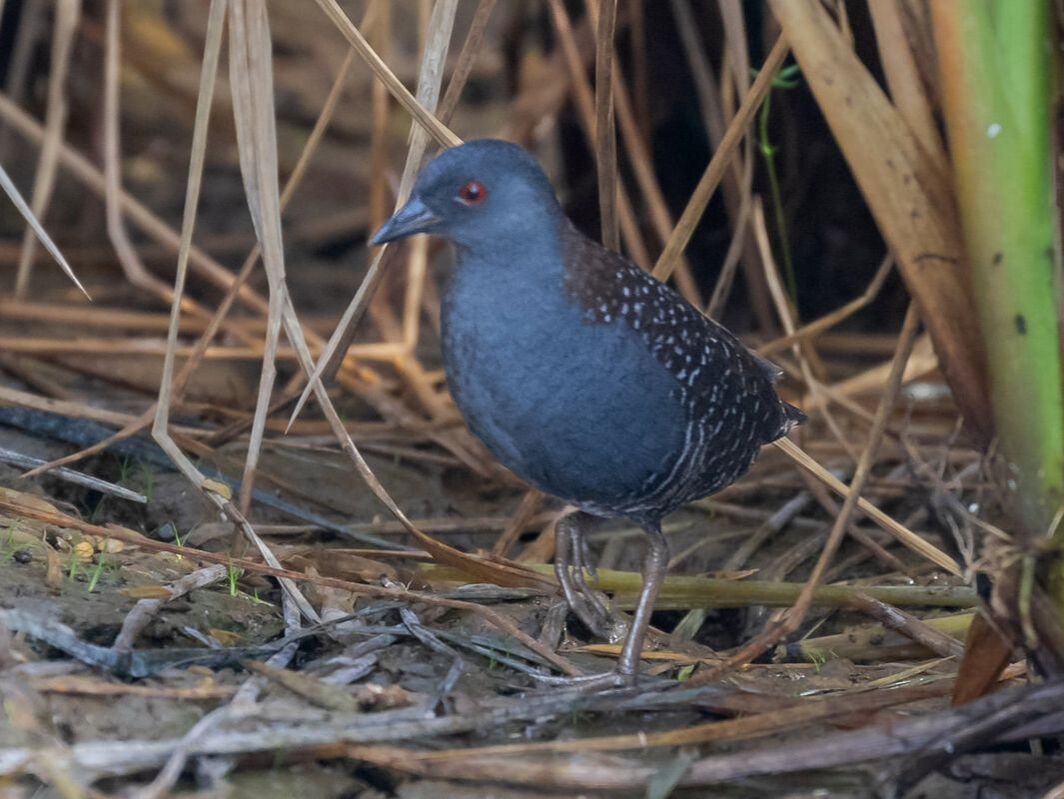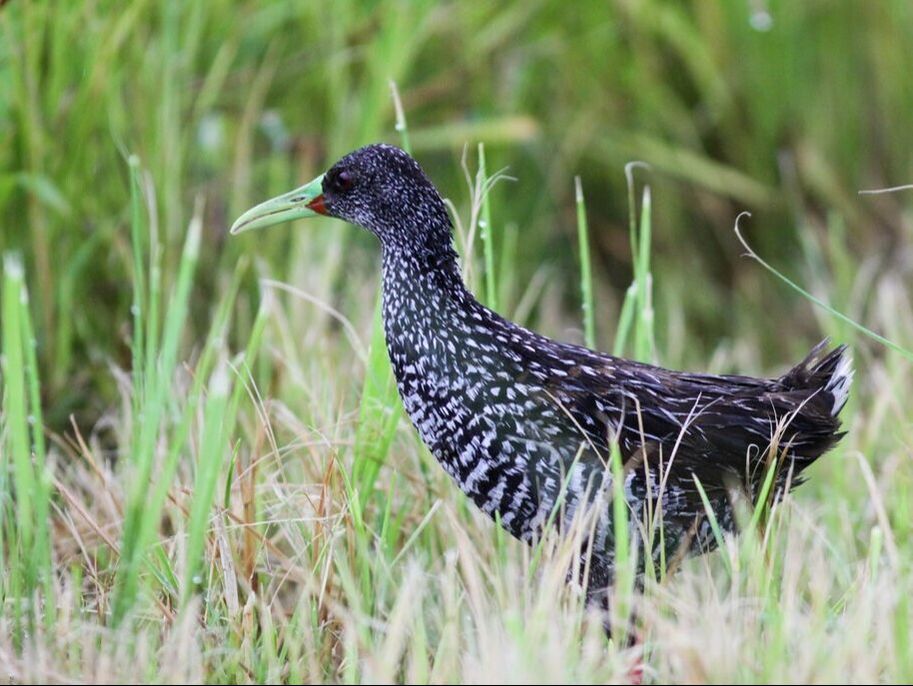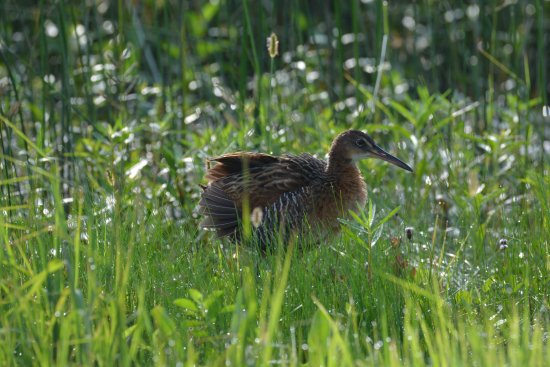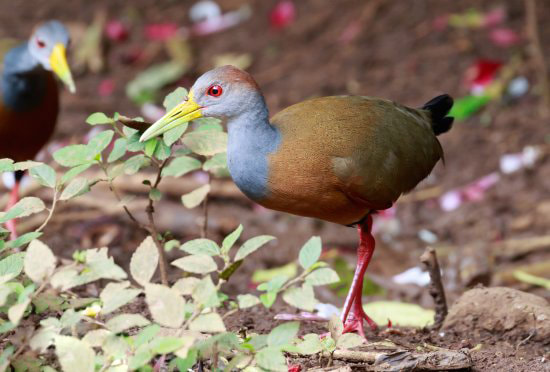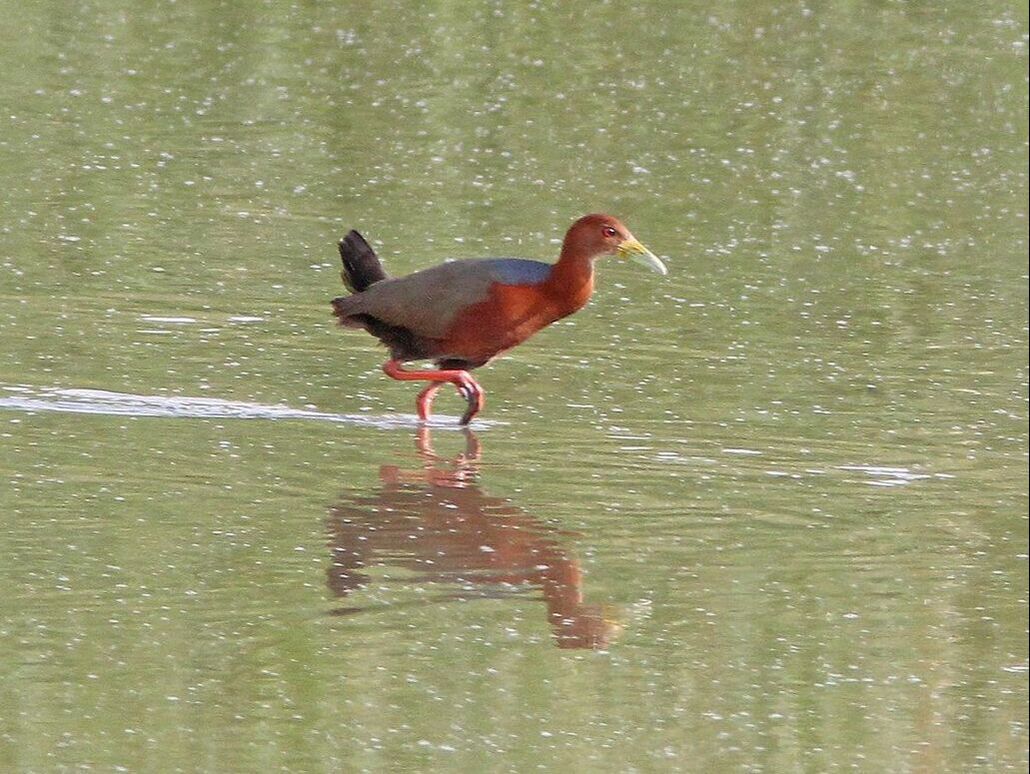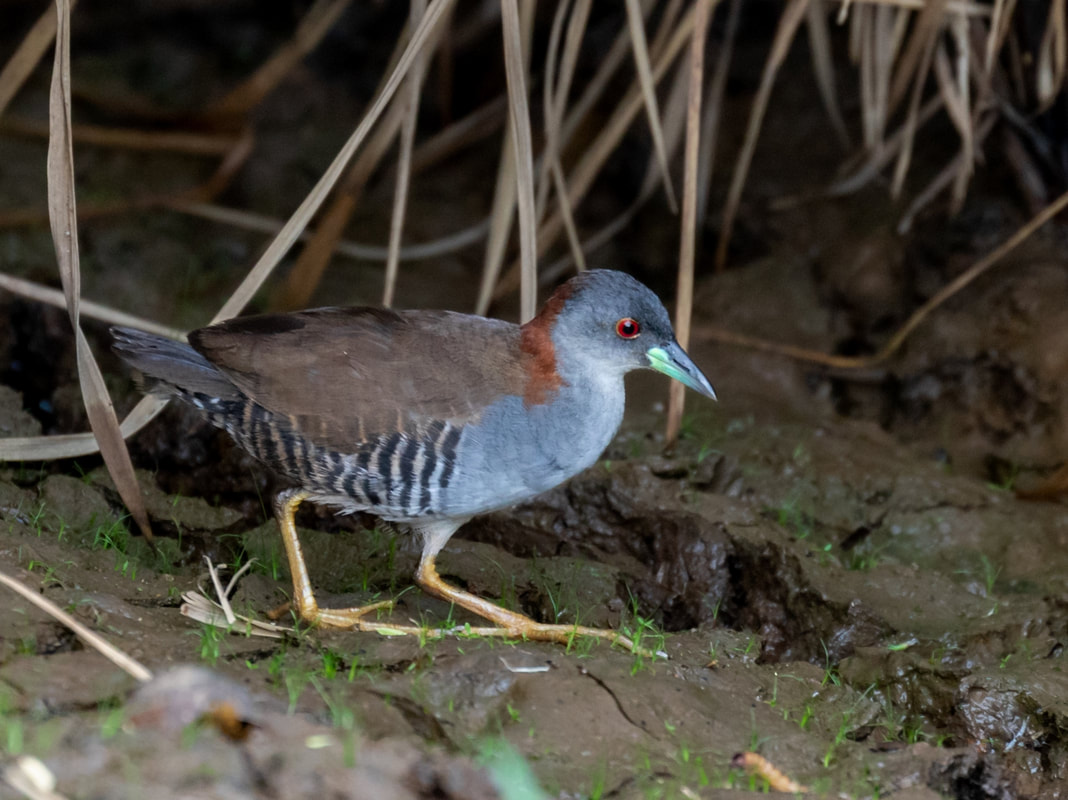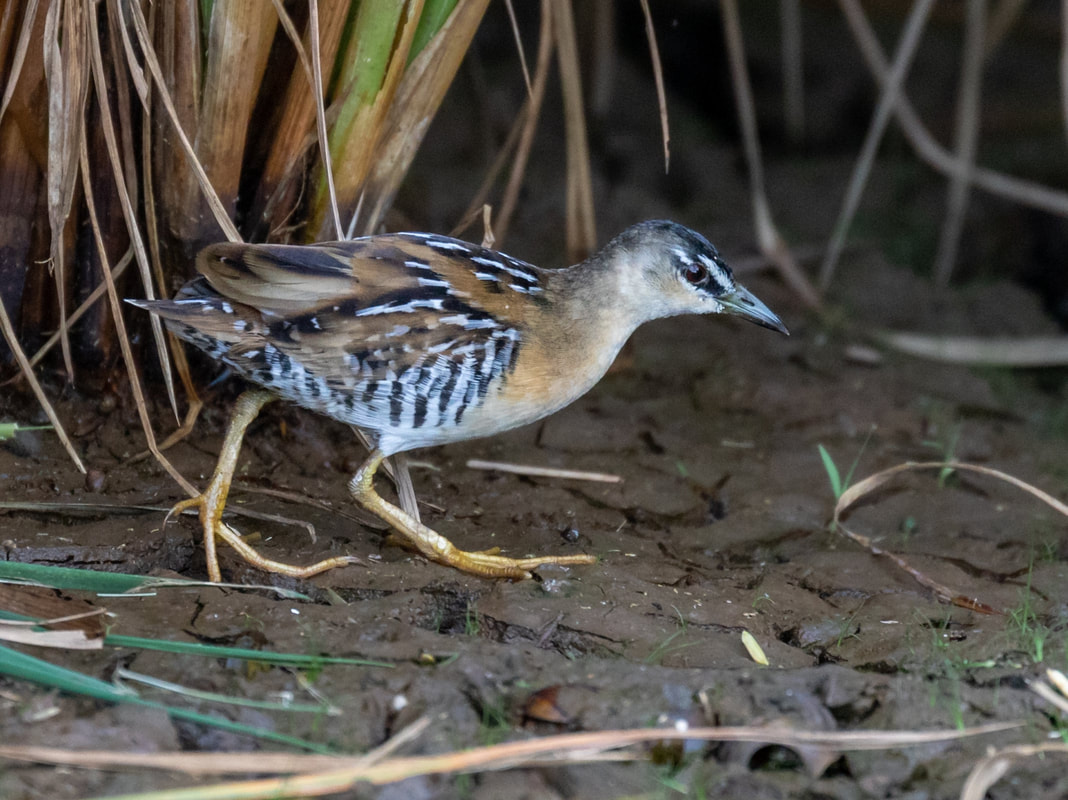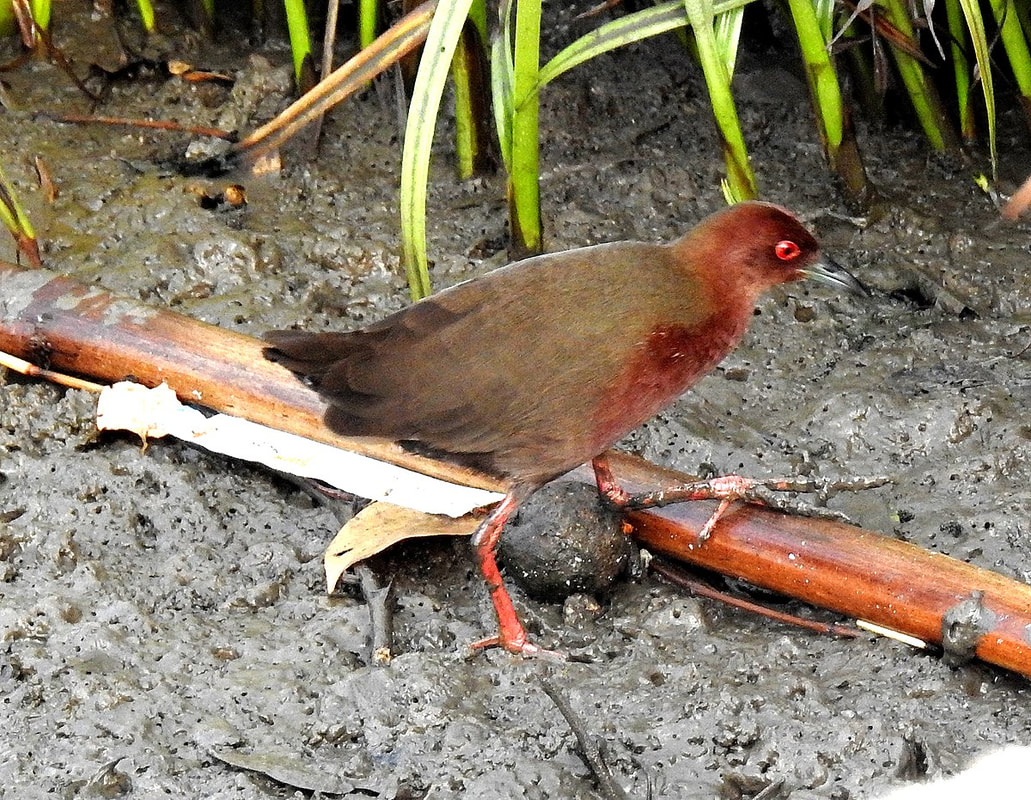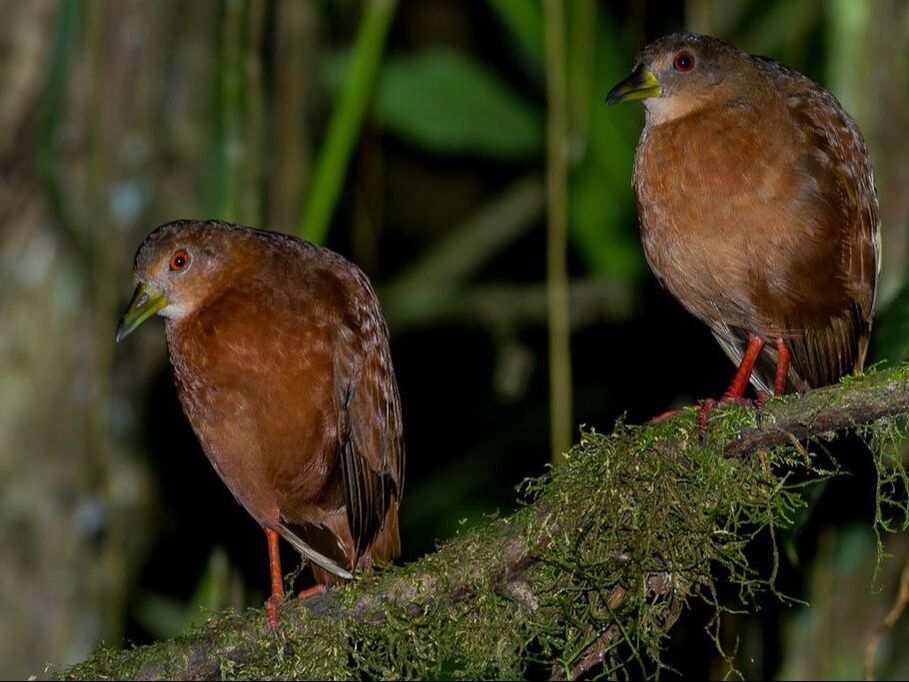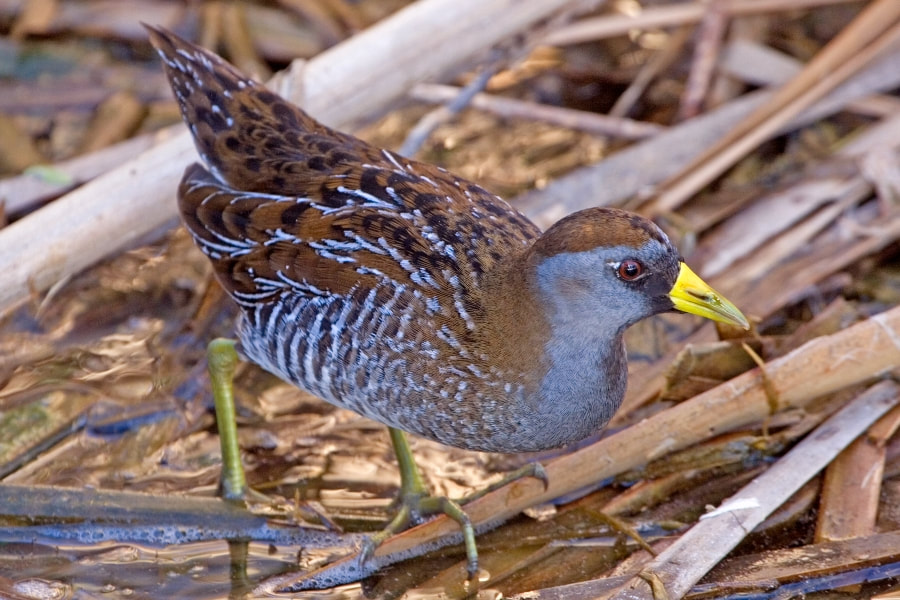Rails & Crakes - in Belize
Black Rail
Black Rail - Tiny rail, the size of a sparrow and nearly impossible to see without tremendous effort. Slate gray overall with a piercing red eye, brown nape, and white spotting on wings. Beware confusion with downy young of other rail species, which are entirely black. Inhabits drier areas in fresh and saltwater marshes with cattail, sedge, and other tall grasses. Typically rare even in proper habitat. Incredibly difficult to locate even when vocalizing within mere feet of an observer; stealthily dashes around at the base of dense grass like a ninja. Easiest to detect by its distinctive song, most often heard at night: a churring "kick-ee-derr", two higher notes followed by a lower note.
BELIZE HABITAT - Seasonally flooded savannas. Where can I find this bird in Belize? Regular and local. Only five documented records, widely scattered, from Orange Walk to Toledo; four were in wnter (Nov. to Mar.), but two individuals collected in northeast Toledo on June 20-30, 1963 were in breeding condition, suggesting that it may occasionally nest in Belize. |
Spotted Rail
Spotted Rail - Elusive, boldly patterned, fairly large rail of fresh marshes in tropical lowlands. Usually elusive, but sometimes walks around in the open at any time of day. No similar species if seen well. Note the brightly colored bill and legs and boldly spotted and barred black-and-white plumage.
BELIZE HABITAT - Ground dweller within primary broadleaf forest. Where can I find this bird in Belize? Uncommon to fairly common but seldom seen resident on mainland south and west of Corozal and Belize, primarily away from coast. |
Clapper Rail
Clapper Rail - Large, generally drab rail, but plumage variable depending on location. Can look very similar to King Rail. Atlantic coast birds dull grayish-brown overall with few contrasting features; faintly barred gray-and-white on sides and pale orange bill. Gulf Coast population brighter with orange neck, more similar to King Rail; note paler and more diffuse barring on sides and less contrasting dark streaks on back. Almost always found in saltmarshes close to the coast, where it can be abundant and vocal. Never in inland freshwater marshes, where replaced by King Rail. Usually shy, but regularly seen feeding along the edge of channels. Listen for series of harsh "kek" notes or loud, rasping grunts erupting from marsh. Sometimes hybridizes with King Rail where fresh and saltwater meet; some birds best left unidentified.
BELIZE HABITAT - Mangrove forest. Where can I find this bird in Belize? Locally common resident on cayes and discontinuously along mainland coast south to north Toledo. Some seasonal movement is indicated by occasional individuals seen away from nesting areas or habitat. |
Gray-Necked Wood Rail
Gray Necked Wood Rail - Large, brightly colored, chicken-like rail of freshwater marshes and damp woodland, less often occurs in mangroves. Unlike many rails, can be conspicuous, even bold, walking in the open along the edge of ponds and rivers, twitching its short black tail; usually seen singly or in pairs. Note long yellowish bill, hot-pink legs, and gray head and neck contrasting with orangey breast. Similar to Russet-naped Wood-Rail, but barely any range overlap, and Gray-cowled has a dull brown patch on the back of the head.
BELIZE HABITAT - Widespread in wet areas, including meadows, marshes, rice fields, open woodland. Where can I find this bird in Belize? Fairly common resident on mainland nearly throughout; once on Ambergris Caye. |
Rufous-Necked Wood Rail
Rufous Necked Wood Rail - Elusive, chickenlike rail of mangroves, less often occurs in freshwater marshes. Slightly smaller than a Common Gallinule. Usually seen walking among mangrove roots, at times coming out in the open on muddy flats. Like most rails, can be trusting if you watch quietly and don’t move. Note bright rusty neck and breast, black flanks and undertail coverts, long yellowish bill, and pink legs (often sullied by mud).
BELIZE HABITAT - Mangrove forest. Where can I find this bird in Belize? Uncommon to fairly common and local on north cayes and in a few places along mainland coast and mangrove-lined cayes south to south Toledo. Apparently only a winter visitor. A growing body of evidence suggests that this species may be an attitudinal migrant, nesting in the mountains forests along the coast. All dated records from Belize are between mid-September and late May. |
Crakes
Gray-Breasted Crake
Gray Breasted Crake - Very small and elusive crake of damp grassy fields, brushy pastures, and marshes. Walks quietly and runs quickly, like all rails. Note the lime-green bill base and red eyes set off by a grayish face. Told from similar Black Rail by yellowish legs and unspotted upperparts. Heard much more often than seen; distinctive piping song easily passed over as a frog. Trilling call is drier than similar call of Ruddy Crake.
BELIZE HABITAT - Wet meadows, rice fields. Where can I find this bird in Belize? Uncommon local resident in south Toledo; recorded also near Middlesex Stann Creek, Monkey Bay Belize, and Gallon Jug Orange Walk. |
Yellow-Breasted Crake
Yellow Breasted Crake - Very small and rarely seen crake of freshwater marshes and ponds in tropical lowlands. May favor areas with water lilies and other emergent vegetation, where it sometimes walks out into view on floating vegetation. Plumage distinctive, with blackish cap and eyestripe, buffy breast, and boldly barred flanks. Flies up weakly when flushed, with yellowish legs dangling.
BELIZE HABITAT - Freshwater marshes, rice fields. Where can I find this bird in Belize? Three sight records, but only one documented: 4 miles west of Belize City on June 27, 1974; Big Falls Farm northeast Cayo on May 24, 1984 (two individuals); Crooked Tree Wildlife Sanctuary Belize on December 1988 and February 1999. As with other secretive rails, may be much more common than the few records indicate. |
Ruddy Crake
Ruddy Crake - A small, elusive bird of freshwater marshes, damp fields, and roadside ditches; heard much more often than seen. Walks quietly and runs quickly, like all rails. Can be confiding if you wait patiently and quietly. Plumage distinctive, overall rich ruddy with slate gray head. Adult has ruby-red eyes, which are duller on immatures.
BELIZE HABITAT - Weedy fields, grass-lined ditches, wet meadows, rice fields. Where can I find this bird in Belize? Fairly common to common resident on mainland; widespread in south but local and less common northward; uncommon on Ambergris Caye. |
Uniform Crake
Uniform Crake - Larger than most crakes. Found in wet forests instead of marshes. Very difficult to see as it creeps through dense understory. Far more easily heard: a series of upslurred whistled notes. Look for a brown bird with richer rufous underparts, a dull greenish-yellowish bill, and reddish legs. Favors dense wet forest or thickets, often but not always near a swamp or stream.
BELIZE HABITAT - Shallow water and drying pools within flooded forest. Where can I find this bird in Belize? Very uncommon and rarely seen resident on mainland in south half; also along New River Orange Walk. |
Sora
Sora - Fairly small rail; short yellow bill, black face, and gray neck distinctive. Found in marshes with grasses or reeds; generally shy but often seen foraging at the edge of shallow water. Buffy juvenile often mistaken for much more secretive Yellow Rail; note different back pattern and the fact that if you see the bird well enough to actually note the back pattern, it is probably not a Yellow Rail. Common call is a descending high-pitched whinny; also gives a whistled "per-WEE" call somewhat like spring peeper but clearer and consistently two parted.
BELIZE HABITAT - Freshwater marshes, rice fields, wet tall grass meadows. Where can I find this bird in Belize? Locally common winter visitor, mid-September to mid-April. |

